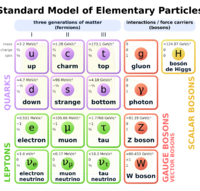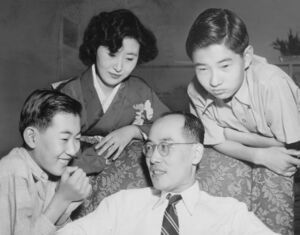Biography:Hideki Yukawa
Hideki Yukawa Junior Second Rank | |
|---|---|
湯川 秀樹 | |
 Yukawa in 1951 | |
| Born | 23 January 1907 |
| Died | 8 September 1981 (aged 74) |
| Citizenship | Japan |
| Alma mater | Kyoto Imperial University Osaka Imperial University |
| Spouse(s) | Sumi Yukawa |
| Children | 2 |
| Awards |
|
| Scientific career | |
| Fields | Theoretical physics |
| Institutions | Osaka Imperial University Kyoto Imperial University Imperial University of Tokyo Institute for Advanced Study Columbia University |
| Academic advisors | Kajuro Tamaki |
| Doctoral students | Kazumi Maki Mendel Sachs Donald R. Yennie |
| Signature | |
Hideki Yukawa ForMemRS[1] FRSE (湯川 秀樹 Yukawa Hideki, 23 January 1907 – 8 September 1981)[2] was a Japanese theoretical physicist and the first Japanese Nobel laureate for his prediction of the pi meson, or pion.
Biography
| Quantum field theory |
|---|
 |
| History |
| Standard Model of particle physics |
|---|
 |
He was born as Hideki Ogawa in Tokyo and grew up in Kyoto with two older brothers, two older sisters, and two younger brothers.[3] He read the Confucian Doctrine of the Mean, and later Lao-Tzu and Chuang-Tzu. His father, for a time, considered sending him to technical college rather than university since he was "not as outstanding a student as his older brothers". However, when his father broached the idea with his middle school principal, the principal praised his "high potential" in mathematics and offered to adopt Ogawa himself in order to keep him on a scholarly career. At that, his father relented.
Ogawa decided against becoming a mathematician when in high school; his teacher marked his exam answer as incorrect when Ogawa proved a theorem but in a different manner than the teacher expected.[3] He decided against a career in experimental physics in college when he demonstrated clumsiness in glassblowing, a requirement for experiments in spectroscopy.[3]
In 1929, after receiving his bachelor's degree at Kyoto Imperial University, he stayed on as a lecturer for four years. After graduation, he was interested in theoretical physics, particularly in the theory of elementary particles.
In 1932, he married Sumi Yukawa (スミ). In accordance with Japanese customs of the time, since he came from a family with many sons but his father-in-law Genyo had none, he was adopted by Genyo and changed his family name from Ogawa to Yukawa.[3] The couple had two sons, Harumi and Takaaki. In 1933 he became a lecturer at Osaka Imperial University, at 26 years old.
In 1935 he published his theory of mesons, which explained the interaction between protons and neutrons at Osaka Imperial University, and was a major influence on research into elementary particles.[4]
In 1938, he received his Ph.D degree at Osaka Imperial University for his predictions regarding the existence of mesons and his theoretical work on the nature of nuclear forces.[5][6] These research achievements were the reason he was later awarded the Nobel Prize in Physics.
In 1940 he became a professor in Kyoto Imperial University. In 1940 he won the Imperial Prize of the Japan Academy, in 1943 the Decoration of Cultural Merit from the Japanese government. In 1949 he became a professor at Columbia University, the same year he received the Nobel Prize in Physics, after the discovery by Cecil Frank Powell, Giuseppe Occhialini and César Lattes of Yukawa's predicted pi meson in 1947. Yukawa also worked on the theory of K-capture, in which a low energy electron is absorbed by the nucleus, after its initial prediction by G. C. Wick.[7]
Yukawa became the first chairman of Yukawa Institute for Theoretical Physics in 1953. He received a Doctorate, honoris causa, from the University of Paris and honorary memberships in the Royal Society,[1] Royal Society of Edinburgh, the Indian Academy of Sciences, the International Academy of Philosophy and Sciences[citation needed], the United States National Academy of Sciences,[4] the American Academy of Arts and Sciences,[7] the American Philosophical Society,[8] and the Pontificia Academia Scientiarum.
He was an editor of Progress of Theoretical Physics,[8] and published the books Introduction to Quantum Mechanics (1946) and Introduction to the Theory of Elementary Particles (1948).
Activism
In 1955, he joined ten other leading scientists and intellectuals in signing the Russell–Einstein Manifesto, calling for nuclear disarmament.
He was one of the signatories of the agreement to convene a convention for drafting a world constitution;[9][10] subsequently, a World Constituent Assembly convened to draft and adopt a Constitution for the Federation of Earth.[11]
Retirement and death
Yukawa retired from Kyoto University in 1970 as a Professor Emeritus. Owing to increasing infirmity, in his final years he appeared in public in a wheelchair. He died at his home in Sakyo-ku, Kyoto, on 8 September 1981 from pneumonia and heart failure, aged 74. His tomb is in Higashiyama-ku, Kyoto.
Solo violinist Diana Yukawa (ダイアナ湯川) is a close relative of Hideki Yukawa.[citation needed]
Recognition

- 1940 – Imperial Prize of the Japan Academy
- 1941 – Academic Noma Award
- 1943 – Order of Culture
- 1949 – Nobel Prize in Physics
- 1963 – Elected a Foreign Member Royal Society (ForMemRS)[1]
- 1964 – Lomonosov Gold Medal
- 1967 – Pour le Mérite[12]
- 1967 – Medal of the Pontifical Academy of Sciences
- 1977 – Grand Cordon of the Order of the Rising Sun
- 1981 – Junior Second Rank (8 September; posthumous)
There is a street, Route Yukawa, named after Yukawa at CERN, Geneva, Switzerland.
Bibliography
- Profiles of Japanese science and scientists, 1970 – supervisory editor: Hideki Yukawa (1970)
- Creativity and intuition: a physicist looks at East and West by Hideki Yukawa; translated by John Bester (1973)
- Scientific works (1979)
- Tabibito (旅人) – The Traveler by Hideki Yukawa; translated by L. Brown & R. Yoshida (1982), ISBN:9971-950-10-3
See also
- Yukawa potential, an approximation for the binding force in an atomic nucleus
- Yukawa interaction
- Progress of Theoretical Physics
- List of Japanese Nobel laureates
- List of Nobel laureates affiliated with Kyoto University
- 6913 Yukawa – an asteroid named after Hideki Yukawa
References
- ↑ 1.0 1.1 1.2 1.3 Kemmer, N. (1983). "Hideki Yukawa. 23 January 1907 – 8 September 1981". Biographical Memoirs of Fellows of the Royal Society 29: 660–676. doi:10.1098/rsbm.1983.0023.
- ↑ "The Nobel Prize in Physics 1949". 23 January 1907. https://www.nobelprize.org/prizes/physics/1949/yukawa/facts/.
- ↑ 3.0 3.1 3.2 3.3 Yukawa, Hideki (1982). Tabibito (旅人) = The Traveler. World Scientific. pp. 46–47 & 118; 121–123; 10; Foreword; 141 & 163. doi:10.1142/0014. ISBN 9971-950-10-3.
- ↑ 4.0 4.1 Yukawa, H. (1935). "On the Interaction of Elementary Particles". Proc. Phys.-Math. Soc. Jpn. 17 (48). https://www.jstage.jst.go.jp/article/ppmsj1919/17/0/17_0_48/_pdf/-char/en.
- ↑ https://www-yukawa.phys.sci.osaka-u.ac.jp/en/wp-content/uploads/2018/11/OU1938-Y1.pdf
- ↑ https://www.ias.edu/scholars/hideki-yukawa
- ↑ 7.0 7.1 Segré, Emilio (1987) "K-Electron Capture by Nuclei", pp. 11–12, chapter 3 in Discovering Alvarez: selected works of Luis W. Alvarez, with commentary by his students and colleagues, Luis W. Alvarez and W. Peter Trower, University of Chicago Press. ISBN:0-226-81304-5.
- ↑ 8.0 8.1 Yukawa Institute for Theoretical Physics; Gakkai, Nihon Butsuri (1946). Progress of Theoretical Physics. Kyoto: Yukawa Institute for Theoretical Physics and Physical Society of Japan. OCLC 44519062. http://ptp.ipap.jp/journal/. Retrieved 2008-03-03.
- ↑ "Letters from Thane Read asking Helen Keller to sign the World Constitution for world peace. 1961". American Foundation for the Blind. https://www.afb.org/HelenKellerArchive?a=d&d=A-HK01-07-B149-F04-022.1.8.
- ↑ "Letter from World Constitution Coordinating Committee to Helen, enclosing current materials". American Foundation for the Blind. https://www.afb.org/HelenKellerArchive?a=d&d=A-HK01-07-B154-F05-028.1.6.
- ↑ "Preparing earth constitution | Global Strategies & Solutions | The Encyclopedia of World Problems". http://encyclopedia.uia.org/en/strategy/193465.
- ↑ "Hideki Yukawa" (in de). http://www.orden-pourlemerite.de/mitglieder/hideki-yukawa.
External links
- Miss nobel-id as parameter
- "Research Profile – Hideki Yukawa". 23 January 1907. https://www.mediatheque.lindau-nobel.org/research-profile/laureate-yukawa.
- Paper: On the Interaction of Elementary Particles. I – paper for which Yukawa received the Nobel Prize
- About Hideki Yukawa
- The short film "Yukawa Story (1954)" is available for free download at the Internet Archive
- Error in Template:Internet Archive author: Hideki Yukawa doesn't exist.
 |


